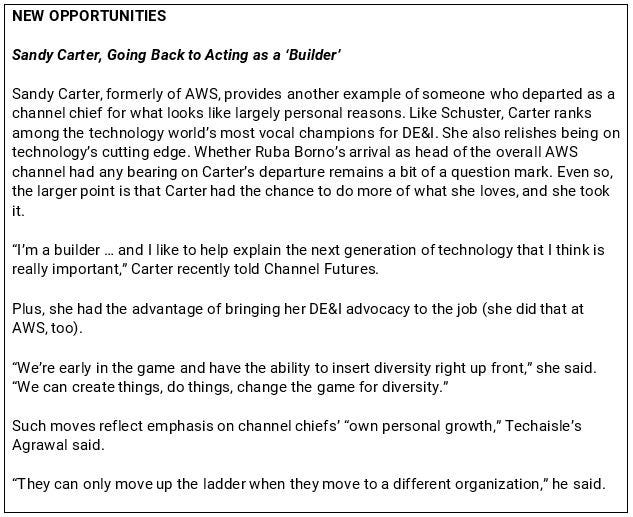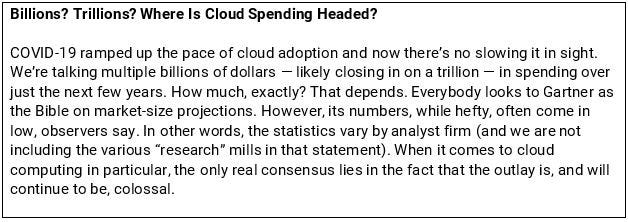What’s Fueling Cloud Channel Chief Turnover at AWS, Azure, Google, More?
In part one of our series exploring recent high-profile turnover, we look at the trends behind the attrition.

Turnover among cloud channel chiefs is raising eyebrows.
In the last year, all three hyperscalers and at least three of the smaller or more peripheral cloud providers have installed new channel heads — some with less publicity than others.
Microsoft Azure kicked off the changes last March. That’s when the company replaced Gavriella Schuster with Rodney Clark. Then came Amazon Web Services, when Doug Yeum left for a retail role at Amazon, succeeded by Cisco’s Ruba Borno. Sandy Carter left as head of the AWS public sector channel, as well. After that, a quiet shuffling at Google Cloud, where Kevin Ichhpurani took over from Carolee Gearhart to no fanfare. And then Rackspace saw sudden turnover when Lisa McLin and Michael Stephens both left — again, with no announcements from the vendor itself. Finally, Intel and Red Hat, too, removed and replaced their top cloud channel executives.
No doubt about it, something appears afoot within the cloud channel. Depending on whom you talk to, the factors influencing the comings and goings vary. For sure, there are some constants, some predictable explanations. And then there are some not-so-standard answers.
Let’s dive in.
Factor 1: Leading a Channel Program Is No Picnic
Regardless of the technology (cloud, network, security, hardware, whatever), spearheading a channel program requires boundless tenacity, vision, energy and complete focus. As part of all of that, a channel chief has to juggle demands from two, sometimes (or, often?) opposed, parties: vendor and partner. It’s hard work, punctuated by the inescapable human realities of corporate politics and interpersonal conflicts.

IDC’s Stuart Wilson
“Fundamentally,” says Stuart Wilson, research director, European partnering ecosystems at IDC, “channel leaders are masters of managing controlled conflict: meeting and exceeding the expectations of partners while simultaneously driving forward an agenda that benefits the vendor. That is a challenging remit that can actually become harder – not easier – the longer a channel leader stays in the same role.”
To be sure, partners know attrition among their channel chiefs is nothing short of inevitable.

Forrester’s Jay McBain
“The tenure of these jobs is short – 4.2 years average – due to the heavy stress and workload,” says Forrester’s Jay McBain.
Part of the stress stems from the sheer competitive nature of the job.
“All these companies want channel chiefs who are well connected, well respected, who are going to continue to drive a growth rate that is almost impossible to satisfy,” says Daniel Newman, founding partner and principal analyst at Futurum Research.

Futurum Research’s Daniel Newman
Due in part to those factors, over at Techaisle, the shelf life for channel chiefs falls far short of 4.2 years.
“In the last 10-15 years, the average tenure of channel chief is about 18 months,” says head analyst Anurag Agrawal. “If a channel chief stays in the role for more than 19 months, then that is something extraordinary.”
Factor 2: People Are People

Techaisle’s Anurag Agrawal
Tenure length notwithstanding, the truth is that working as a channel chief, cloud or not, consumes a person. Long hours, sales quotas, travel — it all adds up.
“There’s so much stress on the job,” McBain says. “It’s like the president of the United States who goes gray in those four years. A channel chief is kind of the same thing.”
At some point, burnout happens (sources say that was the case at Rackspace, where a miraculous …
… turnaround effort succeeded, to the detriment of wearing out the people in charge.).
 So, too, does the desire to pursue something else, or to simply take a break — with or without a pandemic in play. Yet COVID-19, without a doubt, brought introspection to the fore (see ‘New Opportunities’ sidebar, Gavriella Schuster: Pursuing Work ‘That Fuels My Passions’).
So, too, does the desire to pursue something else, or to simply take a break — with or without a pandemic in play. Yet COVID-19, without a doubt, brought introspection to the fore (see ‘New Opportunities’ sidebar, Gavriella Schuster: Pursuing Work ‘That Fuels My Passions’).

Gavriella Schuster
COVID-19 also made clear that virtual connection lacks the sizzle and joy of meeting face to face, and leads to different kinds of burnout. Indeed, channel chiefs found that creating and maintaining loyalty and community with partners proved even more difficult during the pandemic. Video calls and conferences got the job done, but they ultimately felt like cardboard stand-ins for in-person energy and connection. Trying to overcome that particular obstacle drained people everywhere.
All of this is to say that, despite some seemingly superhuman capabilities, the people leading channels are still, well, just people.

“The shuffling of channel chiefs is not entirely surprising in the tumultuous climate of the last two years,” says Carolyn April, senior director of industry analysis at CompTIA. “That said, it’s impossible to pin a single reason on any of the personnel changes. Some of it is personal — new opportunities, new priorities for an individual professional. Some is operational — a company is moving in a new direction and needs new thinking. And some is just normal attrition.” (see ‘New Opportunities’ sidebar, Sandy Carter: Going Back to Acting as a ‘Builder’)
But yes, Virginia, there is more to the turnover story.
Factor 3: Technology and the Channel Are Changing in Significant Ways
For at least a decade, legacy technologies have had to reckon with their dotage. While reports of the death of on-premises applications and hardware may be greatly exaggerated, that doesn’t mean their glory days will return. They won’t.

CompTIA’s Carolyn April
“[W]e can’t ignore the impact that the ongoing shift to a cloud-based services model has had,” CompTIA’s April says. “It has changed the way that technology is bought, sold, delivered and managed.”
 That statement runs deeper than it might appear. Cloud is fundamentally upending everything — how organizations function, how people work and how governments operate. Furthermore, how scientists make advancements and how doctors help patients. How farmers bring food to the public. Cloud adoption sped up, by at least a decade, due to COVID-19 (see sidebar, Billions? Trillions? Where is Cloud Spending Headed?). And that acceleration, this tsunami of digital transformation, is spurring channel-wide evolution that’s hastening the revolving door among cloud channel chiefs.
That statement runs deeper than it might appear. Cloud is fundamentally upending everything — how organizations function, how people work and how governments operate. Furthermore, how scientists make advancements and how doctors help patients. How farmers bring food to the public. Cloud adoption sped up, by at least a decade, due to COVID-19 (see sidebar, Billions? Trillions? Where is Cloud Spending Headed?). And that acceleration, this tsunami of digital transformation, is spurring channel-wide evolution that’s hastening the revolving door among cloud channel chiefs.
Forrester’s McBain attributes this particular upheaval to a global undercurrent, this thing you’ve probably heard him talk about: ecosystem.
In short, “ecosystem” applies throughout the indirect channel. Companies are coming to grips, pretty quickly, with the need to view and treat partners differently than they ever have during the channel’s decades-long existence. The results? Personnel and program changes.
Understand this: If McBain is right – and all evidence points …
… to that being so – “ecosystem” ranks as the main force propelling the cloud channel chief revolving door. (You’re seeing more activity around this trend on LinkedIn as well, from commentary to webinars to an increasing number of job titles that include the word. Look at the position names for the new channel chiefs at Google Cloud and Red Hat as just two examples.) Certainly the other elements – politics, burnout, hitting the ceiling, desire for something new – remain as real as ever. Yet the ecosystem lens magnifies those human normalcies.
In part two of this series, we’ll go a lot deeper into this idea of “ecosystem,” the next wave of channel metamorphosis.
To Sum It All Up
So, what’s going on in the cloud channel? The answer, which will frustrate absolutists, is multifaceted. A huge part of the shift does tie directly to the emerging ecosystem approach. There’s also the inevitable, undeniable effect of wanting to do something else — something that might feel more meaningful and perhaps demand less intensity.
To that point, look at the ages of the cloud channel chiefs affected by the recent turnover. It’s not demeaning to note that most of these leaders have reached their mid-life years. Historically and evolutionarily, that’s the time when many people examine their priorities and desires, and make subsequent changes. That biological reality just so happens to align with an unprecedented tech market — and “very high salaries,” says Futurum’s Newman.
“If you’re talented and mobile, and willing to make a change, the opportunities are going to be abundantly greater than they’ve been in recent history, and that gives them a lot of power,” Newman says. “We’re seeing extraordinary compensation being offered to the right people right now, and that’s very attractive.”
Boiling down all the recent cloud channel chiefs changes to one or two digestible takeaways is, in a word, impossible. Like life, the issue contains nuance and complexity.
“It’s kind of a perfect storm of circumstances right now creating a lot of movement,” as Newman tells us.
With that in mind, we’re treating this topic with the deep exploration it deserves. In part two, soon to come, we’ll go into the ecosystem phenomenon. We’ll also highlight some analyst observation regarding the individual personnel changes at the hyperscalers.
Want to contact the author directly about this story? Have ideas for a follow-up article? Email Kelly Teal or connect with her on LinkedIn. |
About the Author
You May Also Like


